|
AIRCRAFT BACK ON DUTY IN UKIAHJUNE 17 -- UKIAH, CA: Aerial firefighting support is back at the Ukiah Air Attack base for fire season 2004.
 The Ukiah Daily Journal reported that the two CDF airtankers and the OV-10 air attack plane are back on contract until October 15 -- or later if necessary. Last year the tankers dropped 370,000 gallons of retardant out of Ukiah, nearly double the five-year average of 200,000 gallons per season. The Ukiah Daily Journal reported that the two CDF airtankers and the OV-10 air attack plane are back on contract until October 15 -- or later if necessary. Last year the tankers dropped 370,000 gallons of retardant out of Ukiah, nearly double the five-year average of 200,000 gallons per season.
"The challenging part is every fire is different," said pilot Doug Baker. "It's not like it's scripted and you can plan where the fires are."
Baker has been flying tankers for 28 years, and his two sons are also fire pilots.
Baker said there will be a lot less help this season -- which promises to be early, hot, and dry.
"This is going to be an extremely busy fire season, being that we are operating with about half the number of tankers nationwide. The fire conditions are as bad as I have ever seen them."
"Without the nation's fleet of 33 large airtankers, I'll tell you what, we are in trouble," Baker said.
Captain Baker flies Tanker 90, an S-2 owned by the U.S. Forest Service and managed by CDF. T-91, also stationed at the Ukiah Air Attack base, is flown by pilot John Butts.

KACHINA VILLAGE WILDFIRE AVERTEDJUNE 17 -- KACHINA VILLAGE, AZ: A mobile home fire in Kachina Village, on the outskirts of Flagstaff, led yesterday to the evacuation of eight other homes when the blaze threatened to turn into a wildfire.
Firfighters were worried that the extreme fire conditions could have turned the structure fire into a forest fire, according to the Arizona Daily Sun. The national forest border is less than a mile from the mobile home park, and the residential area is filled with pine trees.
Last week, the Forest Service and other area agencies declared extreme fire danger for the Flagstaff area because of extraordinarily dry conditions. Fran Honeycutt, who manages the park, said that each spring she sets up large trash bins so that people can clean up the pine needles and debris from their property.
"This year, they didn't do a very good job of it," said Honeycutt. She said she's kept a list of properties that did not do a good job cleaning and she plans to enforce cleanup.
"I'm going to have to send out a letter that says 'Do it or get out.'"

MORE THAN $40 MILLION APPROVED TO REDUCE
FUELS IN SAN DIEGO COUNTYJUNE 17 -- SAN DIEGO, CA: The San Diego County Board of Supervisors yesterday unanimously approved a program to remove dead, dying and diseased trees in an effort to reduce the risk of wildfires. The Fire Safety and Fuels Reduction Program will be funded with $39.9 million in federal grants to remove fuels in the county's unincorporated areas over the next four years. To augment the USDA grants, the county will add $5 million.
"Two-thirds of the county did not burn in the October fires," said Supervisor Dianne Jacob, "and many communities still face extreme fire danger. Today's action will help to significantly ramp up the removal of dead and diseased trees."
According to a county report, as many as 80 percent of trees in some areas of the county have been killed off by prolonged drought and beetle infestations.
Last month, Chuck Bell, a state conservationist, declared an "extreme emergency situation" because of the dead trees and an early fire season. NBCSanDiego reported that the declaration allows the Natural Resources Conservation Service to use federal funds to cover eligible costs associated with the removal of dead trees in San Diego, San Bernardino, and Riverside counties, without local governments having to match the grants.
The U.S. Forest Service estimates that 62,000 acres of insect-killed trees are scattered throughout Palomar Mountain, Harrison Park, Cuyamaca, Laguna Mountain, Descanso, Pine Valley, and areas near Warner Springs.

UTAH FIRE EVACUATES HOMESJUNE 17 -- DAMMERON VALLEY, UTAH: The night sky was lit up last night north of St. George by a lightning-ignited wildfire that threatened subdivisions along the east side of state Route 18. More than 100 firefighters from the Color Country Interagency Fire Management Area were working on the fire, according to a report by the Salt Lake Tribune.
David Boyd, fire information officer for the Bureau of Land Management in St. George, said three fires were started by lightning at about 6:30 p.m. yesterday. Two of the fires near Dammeron Valley merged, and another fire to the north was threatening the Brookside subdivision south of Enterprise. Part of the subdivision was evacuated as a precaution.
"We're optimistic about the Brookside fire," said Boyd. He said it had burned only 300 acres by 10:30 p.m. but the fire in Dammeron Valley was up to 700 acres. The two fires have been combined and will be managed as the Dammeron Complex by Sexton's Type 1 team. Active fire behavior was observed last night, with torching and spotting three hundred yards ahead of the flame front. The community of Brookside has been evacuated.
Two SEATs and a light helicopter were working the fire, burning in dense sagebrush and piñon-juniper. KUTV news reported that FEMA had approved a fire management grant that will cover 75 percent of the local and state firefighting costs for the fires.

NEW BRUNSWICK FIRE EVACUATES HUNDREDSJUNE 15 -- LOWER COVERDALE, NEW BRUNSWICK, CANADA: High winds yesterday pushed one of the worst fires southeast New Brunswick has seen in two decades. Riverview Fire Chief Doug Hamer said it was the worst fire he'd seen in 20 years, according to a report by canadaeast.com.
The fire in Lower Coverdale burned almost 125 acres, forcing residents from more than 100 homes. The fire started at an airfield between Riverview and Hillsborough.
"The fire was beside the runway, and we tried to stop it but it blew right over us," said the fire chief. "The damn thing's all over the place."
The fire started early in the afternoon and was fought by firefighters from about eight different departments.
The fire was nearly contained last night, and residents were allowed to return home, thanks to the efforts of 90 firefighters, dozers, and eight airtankers -- six planes from New Brunswick that were on the fire all afternoon and two from Quebec that arrived around suppertime. One of the bombers was a TBS Avenger, a plane that was called out of retirement for the fire.
Stephen Tulle, Natural Resources' regional fire management ranger based in Miramichi, said winds were gusting at 63 km/hour (almost 40 mph) at the Moncton airport yesterday and they may have been even higher in Lower Coverdale.
"This was a wind-driven fire," he said. "It was overpowering. When the pilots first arrived they were having trouble assessing their drops." Tulle estimated the fire at 70 percent containment late last night.

AIRTANKERS MISSEDJUNE 14 -- SAN FRANCISCO, CA: Much of the discussion about heavy airtankers fighting fire has flurried around ideas about safety since the May cancellation of federal contracts for heavy airtankers. Recently released statements from the feds, carefully crafted by public affairs folks, wave the safety flag and wax on about how helicopters and SEATs will fill the bill, and glibly remind the public that fires are fought on the ground and not from the air.
That sorta puts the lie to what we've been doing for decades, but at least the federal agency heads are talking publicly about the issue now.
Press releases issued from Boise and Washington, DC are routinely published by many of the print media, especially in the tanker towns -- cities across the West that have hosted airtanker bases for years. And many of them run the "we did it for safety" commentaries without comment. But an editorial in today's San Francisco Chronicle really nailed the issue when it pointed out that the contracts were canceled not for safety reasons but because the NTSB said the federal agencies were liable for accidents.
The editorial says the federal agencies need a new approach to operating a tanker fleet. "They need to set modern requirements for the planes, their maintenance and operation; phase out aging aircraft; and standardize training for pilots and mechanics."
And they quoted Mike Padilla, CDF chief of aviation. "We're already feeling the loss of the heavy tankers," he said; "we could really use them now on the Gaviota Fire."
A May 21 notice from the National Multi-Agency Coordination Group issued instructions to dispatchers and Geographic Area Coordination Centers (GACCs) on the use of aviation resources for the current fire season. "The actions taken are not intended to send a message that the federal agencies will not support our state cooperators," they wrote. However, the GACCs were cautioned that airtankers contracted by individual states -- such as the Butler tankers in Oregon -- cannot be used on federal lands, federal firefighters are not to assume operational control of those airtankers (they must remain under state "operational control"), and federal leadplanes are not allowed to assist these airtankers. The tankers can, however, load out of federal tanker bases.
These restrictions impose a nasty dilemma on the incident commander who finds himself or herself in a situation where tankers are available but can't be used. "On mixed jurisdiction or mixed (state/fed) incident management teams using unauthorized airtankers," said the MAC Group, "state agencies will be responsible for ordering, operational control, and liability associated with those resources."
The MAFFS C-130 aircraft are approved for such fires, and they do have leadplane escorts available -- they are in fact mandatory. The MAC Group rationale for this? They're military aircraft and the Department of Defense has liability, not the Forest Service -- even if it's a Forest Service leadplane with a Forest Service pilot. "The NTSB report does not apply to DOD aircraft because they do not fall under the jurisdiction of FAA airworthiness rules, DOD is the operator and not USDA/DOI," says the MAC Group.
Somehow that doesn't sound like "safety is our first priority." That sounds distinctly like "liability is our first priority."
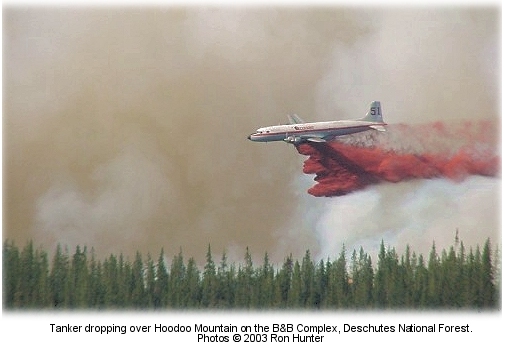
The Chronicle editorial rightly criticized the Forest Service about its new contracts for helicopters and SEATs. "As firefighters will tell you, a helicopter isn't an airtanker. Each has a role in battling wildland blazes. As California heads into what promises to be a long, hot summer, there should be a way to ready the complete array of firefighting tools for the fight against the common enemy -- fire."

INSURERS RELUCTANT TO RESRICT POLICIESJUNE 12 -- SACRAMENTO, CA: Wildfires last fall in southern California were the most expensive in history for the insurance industry, and with another bad season predicted for this year, insurance companies are urging forest-dwelling homeowners to clear brush, trim trees, and take other steps to protect their homes.
So far, though, most insurance companies haven't raised rates or imposed restrictions on homeowners. And according to an AP report, insurers are just hoping that the massive fires of 2003 were a fluke.
"It was an anomaly of sort," said Bill Mellander, spokesman for Allstate, of the California fires. "A fire event of that size you think is not going to be an everyday event."
Insurers processed more than 19,000 claims and paid out $2.04 billion in damages from last October's Cedar and Old fires. That was almost half of all the premiums collected in California the year before. Insurance companies are paying attention to fire forecasts, and they are encouraging homeowners to create defensible space around homes. But they are not making it a requirement of coverage.
Some Colorado insurers, however, take the precautions a step further.
State Farm last year, for example, began requiring 24,000 homeowners in fire-prone areas of six Western states — Arizona, Colorado, Nevada, New Mexico, Utah and Wyoming — to fix hazards on their property. Policies could be dropped if homeowners don't cooperate.
And Colorado Farm Bureau Mutual Insurance Co. has always required homeowners in fire-prone areas to clear brush around their homes.
Foresters and fire managers have encouraged insurance companies for years to require homeowners to clear brush and trees and to use fire-resistant building materials, especially on roofs.
John Garamendi, California's insurance commissioner, says he doesn't understand why more companies don't require those precautions.
"It should be that way," he said. "Some companies do it that way and other companies just look at maps and don't bother looking at the house. They don't have a clue where the house is or what the risks are. I think that's wrong."

THREE FORKS FIRE 15 PERCENT CONTAINEDJUNE 11 -- EAGAR, AZ: Nearly 600 firefighters are working today to keep the 5,800-acre Three Forks Fire from reaching the community of Nutrioso in eastern Arizona; the fire was at 15 percent containment last night and was still three or four miles from the edge of town. Though the fire's size was pegged yesterday at over 7,200 acres, that number was ratcheted back down this morning after better mapping efforts resulted in a more accurate assessment of the fire's size. Fire managers said they've established a trigger point about a mile from town for evacuation orders, should the fire come within range of Nutrioso. Bob Dyson on Kvale's Type 2 team said 25 engines were at Nutrioso in case the fire reaches the trigger point. About 250 buildings are threatened.
An AP report said that residents had evacuated livestock from the town to nearby Springerville and other communities.
Winds of 40 to 50 mph on Wednesday challenged firefighters, blowing embers across firelines and grounding airtankers. Winds caused spotting of up to a quarter mile from the main fire. Helicopters have been dipping from Sierra Blanca Lake to provide air support for ground crews, and Pete Schwab, air operations director for the team managing the fire, said they expected better weather conditions today.

GAVIOTA FIRE CONTAINEDJUNE 11 -- GAVIOTA, CA: A wildfire that burned 7,440 acres of brush and destroyed one home in Santa Barbara County was at full containment last night; cooler temperatures and lighter winds helped more than 1,300 firefighters on the lines of the Gaviota Fire. A quarter of the fire was on the Los Padres National Forest.
An AP story reported that 17 firefighters experienced minor injuries, including 13 who were treated for poison oak; a CDF report put the number of injuries at 26.
The fire started last weekend in the Gaviota Pass north of Santa Barbara, burning across narrow canyons and steep hillsides covered with chaparral. One home was destroyed and three outbuildings were damaged. The fire forced evacuation of hundreds of residents when strong winds pushed the fire, and it resulted in the intermittent closure of U.S. 101.
The Los Padres reported that winds picked up again yesterday afternoon, but that crews were working on suppressing small spot fires within the firelines and finishing hand and dozer lines around the perimeter. A number of resources were released, but those remaining today are working mop-up and patrol. The Santa Barbara County Fire Department will assume management of the fire, which has been under Unified Command, on Saturday morning.

WINDS PUSH ARIZONA FIRE ANOTHER 3,000 ACRESJUNE 10 -- EAGAR, AZ: Nutrioso, an eastern Arizona town of about 500 residents, was smoked in last night from the Three Forks Fire, and residents were being warned that they might have to evacuate if the fire spread to the town.
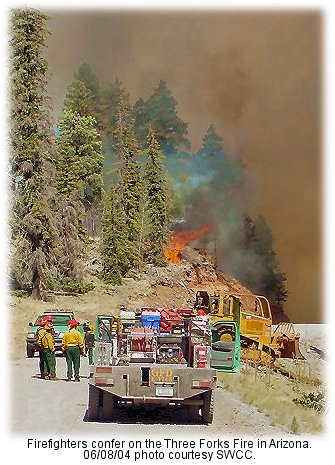 At 5,500 acres last night with about 10 percent containment, the fire on the Apache-Sitgreaves National Forest in eastern Arizona was pushed by winds of up to 40 mph. At 5,500 acres last night with about 10 percent containment, the fire on the Apache-Sitgreaves National Forest in eastern Arizona was pushed by winds of up to 40 mph.
"Everyone I've talked to is more interested in getting their animals out than anything else," said Mike Rising, a retired Forest Service employee who has lived in the area 15 years.
"You can't see it because there's a big ridge between the fire and here, but we've been kind of nervous about what's going on."
The fire was still four miles from town last night.
"This wind is just ripping here," Rising told the Arizona Daily Star. "Right now it's wait and see ... It's anybody's ballgame when the wind goes."
North of the fire in Springerville, winds were clocked at 20 to 30 mph. Gusts near 40 were recorded yesterday afternoon.
Kvale's Type 2 team is on the fire, which started near Big Lake on June 8.
Resources on the fire include eight Type 1 crews, three Type 2 crews, five helicopters, 16 engines, three dozers, and three water tenders.
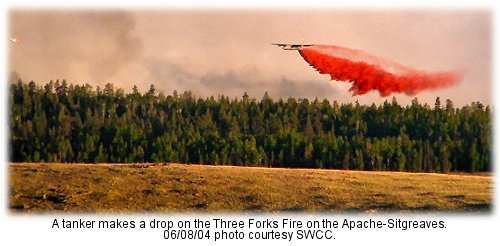
The fire yesterday was torching with short crown runs and lots of spotting. Two C-130 MAFFS units were grounded yesterday because of high winds; west/southwest winds of 10-15 mph are expected for today, with gusts to 30 mph.

NEW ARIZONA FIRE UP TO 3,500 ACRESJUNE 09 -- EAGAR, AZ: A fast-moving wildfire in the White Mountains of eastern Arizona grew overnight to 3,500 acres, according to a report by KVOA-TV; it was estimated last night at just 350 acres.
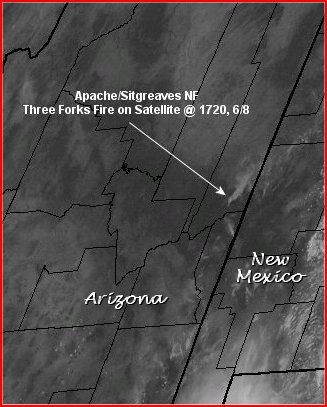 The Three Forks Fire is on the Apache-Sitgreaves National Forest east of Big Lake near the Arizona-New Mexico border. The Three Forks Fire is on the Apache-Sitgreaves National Forest east of Big Lake near the Arizona-New Mexico border.
Early yesterday afternoon, resources on the fire included one SEAT, a helicopter, a dozer, and other local resources. Bob Dyson on the Apache-Sitgreaves said resources assigned later included 140 firefighters, four SEATs, three helicopters, five engines, and four dozers. Hotshots from Heber and Fort Apache were committed last night; two more hotshot crews were on order.
The AP reported that two MAFFS units based at Williams Gateway Airport in Mesa each dropped two loads of retardant on the fire.
Another AP report said that crews on the fire worked on building line and burning out during the night, but that progress would depend on the winds today. Dorman McGann with the initial team on the fire said winds of 30 to 40 mph were expected, with gusts up to 60 mph. "We're hoping that does not happen," McGann said.
According to the Southwest Coordination Center, the fire was 30 percent contained this morning. The fire's expected to spread north today; a Type 2 team has been ordered.
In New Mexico, the 51,685-acre Peppin Fire was 80 percent contained, and crews were securing the western flank and out on patrol for hot spots. Demobilization is under way; the fire has burned 12 cabins since it started on May 15.

OREGON'S AIRTANKER SITUATION UNCERTAINJUNE 07 -- KLAMATH FALLS, OR: A wildfire this summer on state or private land will probably have heavy airtanker support, thanks to a state contract for heavy airtankers. But what if a fire takes off on federal land?
No one knows.
The recent airtanker contract cancellation by the Forest Service and DOI means the two airtankers that were stationed at Kingsley Field last year aren't there now. And officials at the Klamath Falls Interagency Fire Center are waiting to hear whether any of the airtankers will be approved for a return to firefighting.
"As far as right now, there is nothing sitting on the ramp," said Randall Bailey, dispatch coordinator.
Last year, the center moved into its new $4.3 million facility on the east side of Kingsley Field. According to a report by the Herald and News, the tanker base has three concrete pads big enough for a C-130 and a retardant pumping system that can fill large tankers at a rate of 500 gallons a minute. Don Cavin, tanker base manager, says changes will be needed if they have more SEATs assigned at the base. The pumps push the retardant too fast for the smaller tanks to handle.
Over the last five years, the base has supported tankers on about 150 missions a year, Cavin said.
The Oregon Department of Forestry will have two DC-6s from Canada and two DC-7s from Redmond under contract this summer. But the state-contracted planes won't be dropping retardant on federally managed lands, and federal lead planes can't be used to guide state-contracted tankers over fires.

EVACUATED RESIDENTS RETURN HOME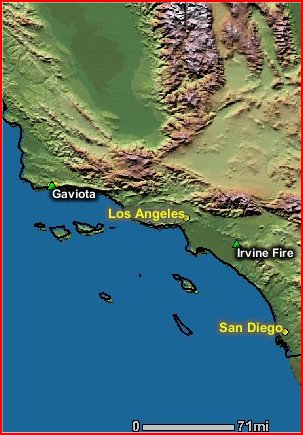 JUNE 07 -- GAVIOTA, CA: Hundreds of southern California residents who were evacuated yesterday from the Gaviota Fire area were allowed to return home last night, according to a FOX news report. The fire, in Santa Barbara County, resulted in the temporary closure of Highway 101 yesterday; it was 20 percent contained this morning at 7,550 acres. JUNE 07 -- GAVIOTA, CA: Hundreds of southern California residents who were evacuated yesterday from the Gaviota Fire area were allowed to return home last night, according to a FOX news report. The fire, in Santa Barbara County, resulted in the temporary closure of Highway 101 yesterday; it was 20 percent contained this morning at 7,550 acres.
Nearly 1,000 personnel were on the fire this morning, with resources including 31 crews, 72 engines, four CDF airtankers, 15 helicopters, and five dozers.
Barry Peckham with the Los Padres National Forest said the fire destroyed one home and damaged some outbuildings. Two oil refineries were threatened, and train trestles owned by Union Pacific were damaged.
The fire threatened 150 homes in the Hollister Ranch community, after it took off Saturday from the Gaviota Pass north of Santa Barbara. The Santa Barbara County Fire Department, U.S. Forest Service, and CDF are operating under Unified Command on suppression efforts.

HELP SOUGHT FOR PRINEVILLE HOTSHOTJUNE 04 -- PRINEVILLE, OR: Matt Taylor with the Prineville IHC is battling cancer and needs financial as well as spiritual support, according to Dan Fiorito with the Union Hotshots. "The Union IHC is auctioning off the very first presentation grade Union Hotshot belt buckle, serial #0001G," says Fiorito. "The belt buckle is brass with silver and gold plating, and will be a beautiful piece of collectable firefighting art."
 The fundraiser for Taylor, who is a former Union Hotshot, is for medical expenses and support of his family. "We are placing a reserve price of $75.00 as a minimum bid," says Fiorito. "All proceeds will be placed (in the purchaser's name) into Matt's Bank of America donation account." The fundraiser for Taylor, who is a former Union Hotshot, is for medical expenses and support of his family. "We are placing a reserve price of $75.00 as a minimum bid," says Fiorito. "All proceeds will be placed (in the purchaser's name) into Matt's Bank of America donation account."
To bid on the buckle and help Taylor, contact the Union Hotshots at (541)962-8541 or email [email protected] or check the online auction page. Bids will be accepted through July 9 and the winner will receive the buckle within 30 days.
Taylor is one of the senior firefighters on the Prineville Hotshots crew. "About six weeks ago he underwent exploratory brain surgery," said Prineville superintendent Lance Honda, "and was found to have an aggressive cancerous tumor." His physician said Taylor has six months to one year to live. He is undergoing chemotherapy and doing what he can to fight the cancer; the chemotherapy runs $2,200 per month. His insurance company is willing to cover half that expense. Taylor's also incurred other medical expenses that his GS-5 salary doesn't come close to covering. The Prineville IHC has opened a donation account with Bank of America to help allay the cost of the chemotherapy and other medical expenses. This account may also double as an education account for Taylor's daughter Jordan, who last month turned one year old.
"The account number with Bank of America is 2884010802," says Honda, "and if you are in another state you can go to your local Bank of America and use the account number OR2-134-01-01 to make your deposit. Any amount, no matter how small, will be very helpful and appreciated very much."

SOUTHWEST FIRE ROUNDUPJUNE 04 -- ALBUQUERQUE, NM: The Tank Fire on the Coronado, which started yesterday, was at 600 acres this morning with about 30 percent containment, according to Crolly's Type 3 team, which is assigned to the fire. Two Type 1 crews, a helicopter, a dozen engines, and five water tenders are assigned. The fire yesterday was torching in brush.
The Peppin Fire on the Lincoln National Forest was 45 percent contained this morning at 44,500 acres. Burning northeast of Capitan, New Mexico, the fire's being managed by Bateman's Type 2 team. Resources include 11 Type 1 crews, two Type 2 crews, 5 helicopters, 16 engines, three dozers, and 16 water tenders. Fire behavior moderated some yesterday with favorable weather, and no significant torching or runs were observed. Burnout operations from both ground and air were attempted yesterday, but results were mixed because of high relative humidity. The fire is expected to move east and northeast today.
On the Apache/Sitgreaves National Forest in Arizona, the KP Fire south of Alpine is 90 percent contained at 16,150 acres. Three Type 1 crews, two helicopters, and four engines are working the fire.
A report in the Arizona Daily Sun said the Agua Fire near Black Canyon City was contained yesterday afternoon.
Investigators said the fire started in a ravine behind a bank, where it spread to two mobile homes and a recreational vehicle. Forty people were evacuated from nearby homes, and about 100 structures were threatened.
The Montezuma Fire south of Sierra Vista was contained at 240 acres. An AP report noted that the fire likely was human-caused because lightning has not struck there recently and the area is known as a hot spot for illegal immigrants crossing the border.

RE-CERTIFYING AIRTANKERS NOT LIKELY IN TIME FOR SOUTHWEST FIRE SEASONJUNE 04 -- TUCSON, AZ: Plans to get airtankers back online for fire duty would likely come too late for Arizona's fire season, according to a report by the Arizona Daily Star.
"It will have a tremendous impact if they can get those planes back in the air," said Dean McAlister, fire management officer for the Coronado National Forest. "I just really don't think any kind of a certification process could happen quick enough for us here, though it may really help states like Oregon, Washington and Montana."
Fire conditions are severe enough in Arizona and New Mexico that nearly 50 percent of the nation's hotshot crews are now in the Southwest. Extra SEATs, civilian and military helicopters, and the C-130 MAFFS units currently in the Southwest aren't seen as an adequate replacement, though, for the heavy airtankers.
The helicopters and SEATs just aren't that effective in the desert Southwest, McAlister said. "They carry a small volume of water and their flight speeds are slow enough that it takes them a long time to do their turnarounds out here," he said.
Big tankers like the four DC-4s owned by Tucson's Ardco Inc. will be missed, said aircraft inspector Tim Amalong, president of Tucson-based Velocity Air Inc.
"I don't think a bunch of smaller aircraft will fill that void, not at all," Amalong said.
Reinspecting and recertifying tankers will most likely take longer than three weeks, McAlister said, and the Southwest fire season often draws to a close with the arrival of monsoons in July. Officials said Wednesday that they have worked with the Federal Aviation Administration to develop guidelines to assess the planes' airworthiness. Ardco's owners say the new standards are just one more chapter in the government's shell game.
"We get the feeling that every time we meet the criteria they ask for, they go and raise the bar on us," said Meegan Garrett. "We're going to be able to meet the new standards, but we just think they're going to raise them on us again."
After two tanker accidents in 2002, the Forest Service contracted with Sandia National Laboratories to develop a safety oversight plan for the country's 33 heavy airtankers. Sandia visited every aircraft operator and came up with recommendations, among them a requirement that each of the planes receive an in-depth inspection. The majority of these inspections were completed by Sandia and the FAA in 2003.
"The Sandia report came out before the fire season last year and we had to meet all the recommendations before we could fly the season, and we did," Garrett said. "Now, they're going to put in even more criteria in the middle of fire season."
Legislators need to get the tankers back in the air as soon as possible, said U.S. Rep. Jeff Flake of Arizona. "I believe the Forest Service's plan to replace these tankers is more expensive, more dangerous, and ultimately less effective," Flake said. He is drafting legislation that would certify tankers that met FAA requirements as of May 31, 2004.

NEW ARIZONA FIRE TAKES OFFJUNE 03 -- BLACK CANYON CITY, AZ: A wildfire burning in the Agua Fria riverbed has burned two trailers and a bus and is threatening about 100 other structures. Cliff Pearlberg with the State Land Department said firefighters from Black Canyon City, Mayer, Phoenix, and Prescott were called in along with multiple aircraft, including SEATs and a helicopter.
The AP reported that the Agua Fire was burning brush and cottonwoods; the fire caused downed powerlines and residential propane tank explosions. The cause is under investigation.
KPHO-TV reported that the fire started when powerlines fell on a mobile home.

MORE RESOURCES HEADED FOR ARIZONA FIREJUNE 03 -- SIERRA VISTA, AZ: Firefighters are hoping to keep a wildfire just north of the U.S.-Mexico border from climbing into the Huachuca Mountains; the Tucson Citizen reported yesterday that 60 firefighters and six aircraft were working on the fire near Coronado National Memorial south of Sierra Vista.
Another 100 firefighters were ordered for the Montezuma Fire, named for the nearby Montezuma Pass. The fire was burning through grasslands and savanna oak in an area between the pass and the Mexican border. If the fire climbs into the steep slopes of the Huachucas, it will burn into heavier fuels such as ponderosa pine.
Two Type 3 helicopters, two MAFFS units, two SEATs, and an air attack crew were on the fire yesterday. The fire was 20 percent contained at 240 acres this morning. According to the Southwest Coordination Center the fire involves several different agencies and poses the potential for international exchange with Mexico on a fire just over the line. The fire yesterday was active on all flanks, making upslope runs and torching in oak and juniper. It's expected to grow to the north if pushed by southwest winds; the forecast includes a chance of dry thunderstorms.
Another fire reported this morning is the Agua Fire, burning along the river bottom near Black Canyon City. It is threatening structures and evacuations are in progress.

SENATORS SPANK REY ON AIRTANKER MESSJUNE 02 -- WASHINGTON, DC: Sen. Ron Wyden of Oregon today slammed what he called a "responsibility vacuum" that led to the cancellation of contracts for heavy airtankers as the 2004 fire season begins. Wyden says he wants the National Transportation Safety Board, the Federal Aviation Administration, and the Forest Service to work together on a reliable safety system for all aircraft used to fight wildfires.
So far no deal from the three of them.
Wyden addressed his concerns to representatives of the NTSB, FAA, and USFS at a hearing of the U.S. Senate Committee on Commerce, Science and Transportation.
"This was a classic responsibility vacuum," said Wyden, "where everyone thought someone else was in charge of ensuring these airtankers were safe for wildfire fighting." Borrowing a phrase from the Forest Service's Tony Kern, he added, "Unfortunately for the communities that depend on them, at the end of the day, nobody was really in control."
Sen. John McCain of Arizona, who chaired the hearing, was not the only Congressman present who berated Mark Rey, Underscretary with the Department of Agriculture, for his drawn-out responses during the hearing. "We are told these cancellations were in response to a Safety Recommendation Letter issued by the NTSB that reviewed three accidents involving firefighting aircraft," said McCain. "However, it should be pointed out that the key recommendation in the NTSB letter was not for the agencies to cancel contracts. It was that the contracting agencies should further develop a maintenance and inspection program to ensure the safe operation of these planes. Rather than instituting such a safety system, however, the agencies involved simply canceled the contracts for the aircraft."
"The land management agencies are responsible for the safety of aviators, firefighters, and the public during firefighting operations and based upon the recommendations of the National Transportation Safety Board," said Rey. "There was no other alternative."
Right.
Wyden also insisted, according to a bend.com report, that the NTSB, FAA, and USFS must ensure in the short term that there is an effective and equivalent wildland fire suppression force for this fire season. Wyden says he'll follow up in two weeks, when the same three agencies will appear before the Senate Committee on Energy and Natural Resources, of which Wyden is a member.
McCain pointed out that the Forest Service had contracted with Sandia National Laboratories to develop a safety oversight plan for these aircraft. Sandia then visited every aircraft operator and developed a number of recommendations, including a requirement that each of the 33 aircraft still under contract would undergo an in-depth inspection. Most of the inspections were completed by Sandia and the FAA in 2003, but McCain pointed out that the NTSB report did not recommend cancellation of the federal contracts.

HUNDREDS EVACUATED BY FLORIDA FIREJUNE 02 -- HAMPTON, FL: A fast-growing wildfire forced the evacuation of hundreds of northern Florida families today, growing from 3,000 acres to about 5,000 acres as it burned near Hampton, 50 miles southwest of Jacksonville. Annaleasa Winter with the Florida Division of Forestry said officials evacuated about 500 people; much of the fire is burning in inaccessible swamp areas.
A Florida Type 2 team is handling the fire, which was 60 percent contained last night after light precipitation fell on the fire area yesterday. The fire was back to 10 or 20 percent containment this morning.
The fire started Tuesday in Sante Fe Swamp, doubled in size overnight, and then doubled again through the day. High winds are pushing the fire north and east toward a more populated area.
"I've seen bad stuff before, but this up there," the DOF's Rick Dolan said. "This is a pretty rough fire. There's a great threat to homes."
News4Jax Channel 4 meteorologist John Gaughan said fire danger remains very high today.

NO AIRTANKERS? HECK, JUST PUT
TANKS IN THE FORESTJUNE 01 -- PASADENA, CA: The U.S. Forest Service in southern California plans to place portable 10,000-gallon tanks in fire-prone locations in the forests, according to a report by the Pasadena Star-News, in order to provide more locations for helicopters to re-fill with water or retardant for fire suppression. Planned locations include the San Bernardino Air Force Base (formerly called Norton), serving the San Bernardino National Forest and in Hemet, which serves the Cleveland National Forest.
"We want to be as flexible and as mobile as possible this summer," said Matt Mathes, media relations officer with the Forest Service. "We will drive the trucks with the 10,000-gallon tanks and retardant-mixing stations to the nearest point to the fire. Then, we'll go to work."
Estimated cost for the portable tanks is between $2,000 and $3,000 per day -- for renting the tanks and flatbeds. Mathes also said the California fleet will be increased from 24 to 30 helicopters as a result of the cancellation of the federally contracted heavy airtankers. "This year we counted on 24 helicopters along with nine airtankers," he said. "Now that we don't have airtankers we are building up our helicopter fleet to at least 30 helicopters across California, 10 of which will be the largest helicopters available in the world."
"We lost a plane in California and one in Colorado during 2002," said Mathes. "Five people were killed. It's unacceptable and irresponsible to continue using aircraft such as these, that clearly are no longer airworthy."

MISSOULA CHAMBER LAUNCHES
GREEN RIBBON CAMPAIGNMAY 31 -- MISSOULA, MT: The Missoula Area Chamber of Commerce has launched a community-wide ribbon campaign to rouse public support for the terminated heavy airtankers.
And the campaign is quickly going national, because of efforts by the Associated Airtanker Pilots and supportive wildland firefighters on the ground.
 "By terminating the contracts for the use of these planes, the U.S. Forest Service is not only doing a disservice to the local economy, but putting the people of our community and their property in jeopardy in the face of what is likely to be another dangerous fire season," said Kim Latrielle, executive director of the Missoula Chamber. "And that’s just wrong." "By terminating the contracts for the use of these planes, the U.S. Forest Service is not only doing a disservice to the local economy, but putting the people of our community and their property in jeopardy in the face of what is likely to be another dangerous fire season," said Kim Latrielle, executive director of the Missoula Chamber. "And that’s just wrong."
Latrielle said they're hoping to raise public awareness of how critical the airtankers are to the protection and safety of their community. Ribbons are available from the Chamber and at area businesses, and Latrielle said they're encouraging community groups to help distribute them.
"Our message is clear," said Latrielle. "Reverse the decision to cancel the contracts and let these tankers fly."
"The airtanker operators in the last year completed all directives of Sandia Labs, the contracted inspection firm designated by the Forest Service and BLM for airworthiness oversight," said Dean Talley, chairman of the AAP, "and they have complied with both the letter and intent of the Forest Service mandate that followed the Blue Ribbon Panel report." He says the airtankers have been inspected and carded, and deemed airworthy and flight-ready by Forest Service maintenance inspectors. Pilots, he said, were issued interagency qualification cards by Forest Service check pilots.
"We believe that canceling the contracts for heavy airtankers creates an unacceptable threat to the public, to ground-based firefighters, to taxpayers' private property, and to the natural resources of the country," said Talley. "We have no intention of flying unsafe aircraft."

AIRTANKERS GROUNDED BECAUSE OF
LIABILITY -- NOT SAFETYMAY 30 -- WASHINGTON, DC: A Forest Service official said Friday that concerns over liability played a role in the May 10 decision to cancel all contracts for heavy airtankers.
"There was certainly a concern about that, but that is not what drove the decision," said Tony Kern, Forest Service assistant director for aviation management. "We were most concerned with the safety of the crews and the people on the ground."
But liability has been an issue between the airtanker operators and the fire agencies for years, and it was liability that drove Forest Service attempts in previous years to ground or take possession of the airtankers. And it's the issue that was spotlighted by the National Transportation Safety Board report that said that the Forest Service had jurisdiction over the aircraft. The NTSB report -- a 152K PDF -- also cited a lack of cooperation among federal fire agencies as a primary factor contributing to the problems with safety in aerial firefighting.
Which agency has the authority and responsibility for the aircraft has long been at issue. "The NTSB said, 'You are the operators,'" said Kern. "We had always thought that the FAA was responsible. It is kind of a really muddy deal. We always assumed that the FAA certificates were issued based on aerial firefighting conditions."
The Billings Gazette reported that the FAA inspects the planes and issues commercial certificates. But according to Kern and FAA spokesman Les Dorr, the inspections do not test for the stresses related to fighting wildfires. The inspections are the same as those performed on commercial aircraft. The NTSB report, released in late April, said the Forest Service and BLM have jurisdiction over the planes, and it pointed out that the agencies have no way to certify that the planes can operate safely.
Kern said that airtankers often fly over cities when they are full, and the heavy loads stress the planes. He said one of the tankers that crashed lost its wings during regular flight -- not on a firefighting mission.
"The wings just came off while the damn things were flying along," Kern said. "The wings just came right off."
He said a town mayor in the Northern Rockies had expressed concerns because airtankers flew over the city after taking off from its airport. Kern said the mayor wrote, "I expect the federal government to guarantee that these planes will not come apart over the heads of the public." Kern said the Forest Service could be liable if there were such an accident.
"This could end up with a plane landing on a school," Kern said. "You are talking about the potential for negligent homicide."

FUEL TRUCK DRIVER INJURED ON ARIZONA FIREMAY 27 -- HANNAGAN, AZ: The driver of a truck delivering fuel for firefighting equipment on the KP Fire was injured last weekend when his truck rounded a sharp curve, slid over an embankment, and rolled over on U.S. Hwy. 191. The Eastern Arizona Courier reported that the wreck occurred about 10 miles south of Hannagan.
The man, whose name was not released, was transported to a hospital in Tucson.
Neither smoke nor lack of visibility was a factor in the crash, Fire Information Officer Jonetta Holt said.
The KP Fire near Hannagan Meadow, south of Alpine, has burned over 10,000 acres and is only 25 percent contained. U.S. 191 between Clifton and Alpine is partially closed because of smoke and safety concerns for firefighters and equipment, which are often on the highway. U.S. 191, also known as the Coronado Trail, was closed from Hannagan Meadow to a point 13 miles south of there last weekend, and is expected to remain closed this coming weekend. The highway, narrow and winding, is considered one of the most scenic in Arizona and draws many tourists. It climbs to an elevation of over 9,000 feet at Blue Vista, south of Hannagan.

PEPPIN FIRE AT 25,000 ACRESMAY 27 -- CAPITAN, NM: At zero percent containment, the Peppin Fire in New Mexico's Capitan Mountains has burned a dozen cabins, according to AP reports, and burnout operations are planned for today. Crews yesterday put in line along the northern perimeter of the fire.
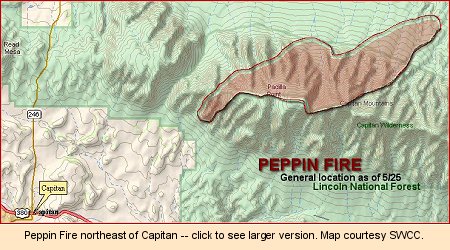
Lighter winds, overcast conditions, and higher humidity helped slow the fire, but rugged terrain has made it impossible to gain much progress, and thunderstorms are in the forecast.
Bateman's Type 2 team is assigned to the fire, which is on the Lincoln National Forest north of Capitan. Resources include 12 Type 1 crews, two Type 2 crews, five helicopters, 23 engines, four dozers, and 14 water tenders, with a total of 471 personnel.
On Arizona's KP Fire, managed by Kvale's Type 2 team, poor access, heavy fuel loads, and steep rugged terrain have hampered suppression efforts. The fire, on the Apache/Sitgreaves, was 25 percent contained at 10,000 acres last night. Fire behavior was less active yesterday; U.S. Highway 191 remains closed to the public.

NEW MEXICO FIRE QUADRUPLES IN SIZEMAY 24 -- CAPITAN, NM: A wind-driven fire has blown from 2,400 acres to about 10,000 acres overnight Sunday in the Capitan Mountains of central New Mexico. The Peppin Fire also evacuated seven homes.
"We had a 15-mile flame front last night," Beth Wilson, fire information officer, said this morning. "Basically, it burned up the better part of the northern Capitan Mountains." Dangerous conditions, fire behavior, and rough country have prevented firefighters from using direct attack on the fire. "It's just nasty terrain," said Wilson, "very steep, very rocky, very dense."
Aircraft have been dropping retardant and water around communications towers on Capitan Peak, according to AP reports, and firefighters were focusing on protecting homes east of the fire.
Fifty miles northwest, the Lookout Fire has burned 4,600 acres west of Corona on the Cibola National Forest. The human-caused fire is at 40 percent containment; Winchester's Type 2 team is on the fire, along with seven Type 1 crews, five Type 2 crews, four helicopters, seven engines, a dozer, and five water tenders. The fire yesterday exhibited intense fire behavior with upslope runs, backing, and torching. Two residences and two outbuildings have been destroyed.
In Arizona, firefighters burned out along State Highway 191 on the 4,000-acre KP Fire on the Apache-Sitgreaves National Forest south of Alpine. It's about 15 percent contained, with 583 firefighters assigned. Kvale's Type 2 team is on the fire, with 15 Type 1 crews, two Type 2 crews, three helicopters, 21 engines, two dozers, and eight water tenders. Significantly greater active fire behavior was a problem yesterday, with short uphill crown runs, short-range spotting, and group torching. Burnout operations were completed along the western boundary.

OREGON DECLARES STATE OF EMERGENCYMAY 24 -- GRANTS PASS, OR: The state forester in Oregon has declared a state of emergency over the loss of heavy airtankers and is seeking to contract airtankers on its own. The Oregon Department of Forestry said today the agency wants two airtankers available as early as July 1 in addition to two tankers and two lead planes due to arrive August 1 after they have completed work in Alaska.
"Aircraft are integral to our aggressive firefighting strategy," said Bill Lafferty, director of fire protection for the department.
The AP reported that State Forester Marvin Brown declared an emergency last week in response to the shortage of airtankers and expectations of an above-average fire season.
A bend.com report said the emergency declaration enables ODF to secure its own aviation contracts for other tankers and helicopters to offset the loss of the federal tanker fleet. The heavy airtankers have for years been a key element in the ODF's efforts to protect the 16 million acres of forestland under its jurisdiction. In previous years, seven airtankers from the federal contract fleet have been available in Oregon and Washington.
"We have an agreement with the State of Alaska to have two of their contract tankers and two lead planes brought down to Oregon around August 1," said Lafferty. Last year, after the federal fleet was downsized by 11 planes, the department secured one airtanker and a lead plane from Alaska under the authority of the Northwest Compact Act, which is an agreement to share resources among member states and Canadian provinces. The Alaskan airtanker saw plenty of action throughout the state last summer.
To help offset the loss of the heavies, the ODF is trying to assemble an air attack capability of four large tankers and seven helicopters.
Federal airtankers were to be based in Redmond, La Grande, and Klamath Falls; Western lawmakers and governors also have mounted a campaign to get at least some of the canceled tankers back into operation.

ALASKA WANTS AIRTANKERS REPLACEDMAY 24 -- FAIRBANKS, ALASKA: The Alaska Fire Service has requested three smaller aircraft to replace the two large contracted tankers that were recently canceled by the federal fire agencies. The AFS planned to have two DC-4s on this season, each with a 2,000-gallon retardant capacity, and now has requested from NIFC two medium-sized tankers and a SEAT.
The season has just begun in Interior Alaska, according to an AP report, and will last through late July. The state has two DC-6 tankers on contract from Conair Aviation in Canada that were unaffected by the federal cancellation. The AFS is requesting two Canadair CL-215s -- medium-sized tankers with a 1,400-gallon capacity -- one Airtractor 802 with an 800-gallon capacity, and two medium helicopters. The agency's also requested extra smokejumpers for the season.
Sen. Lisa Murkowski of Alaska has written Secretary of Agriculture Ann Veneman asking how the federal government plans to address the loss of heavy airtankers in Alaska. Murkowski noted that the Canadian government, unlike the U.S., specifically certifies aircraft for retardant operations.
"Why, then, does the United States not recognize this airworthiness certification?" she asked.

SEASON OUTLOOK GOES FROM BAD TO WORSEMAY 22 -- BOISE, IDAHO: Months ago, national fire managers predicted the 2004 wildfire season would be a bad one; now they say it will be even worse than they thought. Unseasonably warm weather in March and April, heavy dry fuels, continuing drought, and the loss of the nation's heavy airtankers combined mean the grim possibility of another devastating fire season.
"Things are much worse than they were in February," said Rick Ochoa, national fire weather program manager at NIFC.
Years of drought have left states across the West vulnerable to extreme fire conditions, and according to AP reports, about a dozen Western states face the possibility of an above-average fire season. The Pacific Northwest looked good early on, with heavy snow in the Cascades. But warm spring temperatures melted the snowpack a month early. The Washington state DNR has already had 70 small fires, up from their usual 20, and forest conditions now resemble typical late July conditions.
In Oregon, snowpack in the Cascades fell from 120 percent of average in early March to just 53 percent of average on May 1.
"It really is huge," said Paul Werth, fire weather program manager for the Northwest Interagency Coordination Center in Portland. "There's really the potential for a large number of huge fires -- long duration fires."
Losing 33 large airtankers won't help, either. "Those airtankers were critical for initial attack," said Dan Ware with the New Mexico State Forestry Division. "They buy time for your fire crews." New Mexico has repositioned other resources around the state, and now has two National Guard helicopters available for initial attack.
Fire crews were pulled off the Lookout Fire near Corona late yesterday because of high winds, according to an AP report; the fire's burned over 1,500 acres and destroyed a couple buildings. Winds were about 18 mph early today, but were expected to increase. The National Weather Service in Albuquerque issued a wind advisory from noon until tonight for much of eastern New Mexico.
Fire officials in Arizona plan to request $1.5 million from the governor to add more bulldozers and more firefighters in rural and volunteer fire departments. And even before the federal agencies announced the cancellation of the heavy airtanker contracts, the state had contracted four private tankers to boost firefighting efforts.
"If I'd seen it coming, I'd have hired 20 of them," said Kirk Rowdabaugh, deputy state forester for Arizona. "We're putting more emphasis on bulldozers, but there are environmental consequences. It's not something we'd like to do, but in the absence of the heavy airtankers, it's something we may have to do."

NEW MEXICO FIRE EVACUATES RANCHESMAY 21 -- CORONA, NM: A wildfire estimated at 1,000 acres forced several evacuations in Corona today; the Lookout Fire started in Gallinas Peak, southeast of Mountainair, this morning. Fire officials said it has spread very quickly to the Cibola National Forest near Corona, where it's crowning. SEATs, engines, and a 20-person crew are on the fire.
Along with the evacuated ranches, the fire also threatens television and cell phone towers on the mountain, according to TheNewMexicoChannel.com, which reported winds at about 20 mph with gusts to 45 mph.
A Type 2 team and more hotshots were ordered for the fire this afternoon. The Southwest Area was bumped up to Preparedness Level 3 effective today.

EXTRA $500 MILLION FOR FIRE?MAY 21 -- WASHINGTON, DC: Lawmakers yesterday introduced a bill to fund an extra $500 million for federal firefighting agencies. "If the president won't act, we will," said Rep. Peter DeFazio of Oregon. "The fire season has only just begun and the Forest Service has grounded the firefighting tankers, is short personnel, and admits they only have half the money they need for the entire fire season."
State and federal agencies reported spending an estimated $1.5 billion last year on fire. After several years of drought, many Western states are now facing the possibility of an above-average fire season. Conditions are prime for a bad season in the Pacific Northwest, the Northern Rockies, and the Southwest, including southern California, where conditions are the driest.

MAN GETS PROBATION FOR LYING DURING WILDFIRE INVESTIGATIONMAY 21 -- TUCSON, AZ: Kenzo Butler, who earlier told investigators that he had not been smoking while hiking on the Aspen trail the day the Aspen Fire started, was sentenced today to two years' probation for lying to authorities. The fire destroyed Summerhaven, a vacation community on Mount Lemmon, last year.
Butler must also complete 200 hours of community service, according to an AP report.
He pleaded guilty in March to two federal counts of providing false statements to U.S. Forest Service investigators. The Aspen fire near Tucson was the most destructive wildfire in Arizona in 2003, burning 84,000 acres and destroying 335 homes.

TAHOE AREA EXPECTING HOT DRY SUMMERMAY 20 -- SOUTH LAKE TAHOE, CA: Fire conditions in 2004 look a lot like fire conditions in 2003 -- or worse -- with drought conditions predicted to last through summer; record high temperatures in March and April caused a premature snowmelt, according to the Tahoe Daily Tribune. Gary Barbato, hydrologist for the National Weather Service, said water levels are down from the last few years' levels.
"The snowpack is pretty much done," said Barbato. "If you look at the levels, on the rivers it is pretty dismal. We're even behind where we've been the last couple of years."
And fire managers are expecting the fire season to be severe. The warm and dry weather makes the forested lands of the basin highly sensitive to fire earlier than average, said Rex Norman with the Lake Tahoe Basin Unit of the Forest Service.
"Here in the Lake Tahoe Basin, we are moving into fuel moistures that would normally be seen later in summer," he said.
To counter the threat of wildfire to communities and resources, the Forest Service has treated more than 32,000 acres, primarily near vulnerable communities. Although there has been significant progress, more needs to be done. But fire managers warn Sierra and Tahoe residents not to assume that community defense treatments can "fireproof" communities.

REMEMBERING THE MT. LEMMON FIRESMAY 21 -- TUCSON, AZ: Roy and Carol Lundstrom moved to Summerhaven in August 2001. Little did they know they would endure the devastation of two major wildfires. The Tucson Citizen reported that the fires changed not only their outlook, but also those of their neighbors and forest managers as they prepare for another fire season. The Lundstroms had lived in their cabin about nine months when the Bullock Fire took off in the early morning hours, two years ago today.
Gail Aschenbrenner, with the Coronado National Forest, remembers the fire. "At seven that morning, I was out at the base camp on Redington Pass Road," she said, "standing there with the incident commander and a Northwest crew watching the helicopter take off."
But the helicopter didn't fly much that day. High winds grounded aircraft, and Aschenbrenner got the idea early on that the fire would get away. "I remember walking to the top of one of those hills, trying to get cell service," she said. "I was having a sinking feeling. We were losing those golden hours of opportunity."
Those early hours of initial attack on a fire are often what makes the difference between a small fire successfully contained and a major rager of a campaign fire that burns thousands of acres and requires millions of dollars in suppression costs. And with the recent cancellation of heavy airtanker contracts by the Forest Service and the Department of Interior, a vital firefighting tool has been taken away from fire management and firefighters.
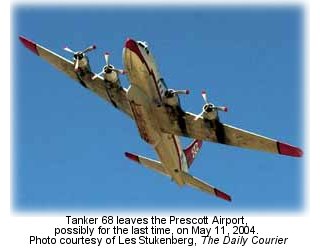 The Prescott Daily Courier reported that Forest Service officials said they didn't have the time before the upcoming fire season to develop maintenance and inspection programs for the planes as the National Transportation Safety Board recently recommended, so they decided to cancel the contracts for the heavy tankers. The NTSB report noted that aerial firefighting companies often can't acquire a complete service history on their aging planes; maintenance crews for the two heavy tankers that were stationed at the Prescott Fire Center said their companies have records dating back to the planes' early days. The Prescott Daily Courier reported that Forest Service officials said they didn't have the time before the upcoming fire season to develop maintenance and inspection programs for the planes as the National Transportation Safety Board recently recommended, so they decided to cancel the contracts for the heavy tankers. The NTSB report noted that aerial firefighting companies often can't acquire a complete service history on their aging planes; maintenance crews for the two heavy tankers that were stationed at the Prescott Fire Center said their companies have records dating back to the planes' early days.
The heavy airtankers have decades of history in slowing wildfires and working with ground crews to contain fires early -- which is critically important in the burgeoning wildland/urban interface of Western states.
The Coronado National Forest is situated next to several rapidly expanding urban areas -- Tucson, Oracle, Sierra Vista, Nogales, and Sonoita/Patagonia. Approximately 34,000 acres of the Forest are classed wildland/urban interface, and in the Tucson area alone there are approximately 60 miles of interface. The mixture of houses, flashy fuels, and brush fields in full view of a large metropolitan area adds significantly to the challenges and complexity of even small wildland fires.
After the Bullock Fire and last year's Aspen Fire, residents and the fire agencies are more pro-active than they were. "It's such a changed world," said Josh Taiz, biologist on the Coronado National Forest. "There's been a real loss of innocence. In the past, if a wildfire got up to a couple thousand acres, it seemed like a really big fire."
Taiz said planning for fires that require hundreds of firefighters, aircraft, and engines is integral to fire season preparations. The fire season generally runs from April through November, and the average fire occurrence is 150 fires each year, for a total of 9000 acres. Nearly 70 percent of all fires are lightning-caused.

RED FLAGS OVER THE SOUTHWESTMAY 21 -- CLOUDCROFT, NM: New Mexico's Lincoln National Forest hasn't seen any huge fires yet this year, but it's probably a matter of time -- and luck. "Needless to say, we're not as bad off as in the past few years," said James Villard, fire management officer for the Sacramento Ranger District on the Lincoln.
Crews have been working on fuels projects and prescribed burns, according to the El Paso Times, but fire managers are keeping an uneasy eye on the weather -- and are unhappy about the cancellation of the federal heavy airtanker contracts.
"The grounding of the heavy airtankers has hurt our response quite a bit," Villard said. He added that they were missed earlier this week on a fire near Timberon. "We would have used heavy airtankers continuously" on that fire, he said. "The single-engine tankers were not able to get through the canopy where we wanted to be."
The Southwest Coordination Center reported this morning that a second SEAT and lead plane were ordered for the Lookout Fire on the Cibola National Forest. A Type 2 crew is assigned.

NEW MEXICO SCORES BLACKHAWKSMAY 20 -- SANTA FE, NM: Two National Guard Blackhawk helicopters will be available for initial attack on fires; the state requested the helicopters in response to the cancellation of federal airtanker contracts by the U.S. Forest Service and Department of Interior.
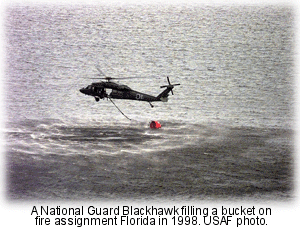 Joanna Prukop, secretary of the state Energy, Minerals and Natural Resources Department, said they're working with the federal agencies to augment fire resources around the state. Joanna Prukop, secretary of the state Energy, Minerals and Natural Resources Department, said they're working with the federal agencies to augment fire resources around the state.
"The state of New Mexico and our partners are doing everything possible to counter the loss of the airtankers by adding as many other resources as are available," said Prukop.
This will be the first time Blackhawks have been used on initial attack in New Mexico, according to an AP report.
The state Forestry Division purchased two bambi buckets for the helicopters, each with a maximum capacity of 400 gallons.
Fire crews, meanwhile, are working a fire of about 100 acres on the Lincoln National Forest; the Peppin Fire was ignited by lightning on Saturday northeast of Capitan. According to an AP report, two SEATs and a helicopter were dropping water, with about 60 firefighters assigned. The fire was 20 percent contained at 120 acres last night; crews were challenged by steep rugged slopes, erratic winds, and difficult access. More lightning moved through last night on the east side of the Capitans and Sacramento Mountains.
The KP Fire south of Alpine last night was estimated at between 800 and 900 acres; Kvale's Type 2 Team was scheduled to take over the fire today. Significant spread to the northeast happened yesterday under afternoon high winds, and the fire was torching in timber.

CONGRESSMEN SAY MAYBE YES ON AIRTANKERSMAY 18 -- WASHINGTON, DC: Some of the country's contracted heavy airtankers could be restored to service this summer, according to some members of Congress, who said today that eight of the 33 tankers could be in the air again if they're determined to be safe and if their complete records can be located. FAA officials aren't promising, but have said they'll work with the Forest Service to develop a system for certification.
According to an AP report, the Forest Service and BLM -- not the National Transportation Safety Board or the Federal Aviation Administration -- are responsible for certifying that planes used for public purposes are safe. The Forest Service, however, wants the FAA to bear responsibility for certifying the airworthiness of the airtankers. Lawmakers and the federal agencies involved agreed today to develop an inspection system to ensure airworthiness. They will focus on eight P-3 Orions -- owned by Aero Union Corp. in California -- which have a more detailed history than other converted military planes.
The aircraft could be recertified as soon as mid-June, said Rep. Peter DeFazio of Oregon.
"I'm pleased that we've broken the bureaucratic logjam so we can have large tankers safely in the air this fire season," DeFazio said. "Grounding the entire fleet of large tankers has left a huge hole in our firefighting resources that I feel cannot be filled in any other way."
Les Dorr, a spokesman for the FAA, said he could not speculate whether any or all of the 33 tankers would be certified for use this summer, saying that decision is up to the Forest Service.
Meanwhile, the president of Aero Union of Chico, California, one of the operators whose contracts were canceled last week, said the company is unfairly being lumped in with a Wyoming firm responsible for most of the catastrophic accidents. In a report by KTVU-TV, Terry Unsworth said that Hawkins & Powers of Greybull, Wyoming, was responsible for five of the six structural accidents in the last 30 years. He cited Aero Union an example of a company that was able to maintain high standards and avoid problems by upgrading its planes and training its pilots. Unsworth said the company plans to fight the contract cancellation by seeking support from Congress. He also said Aero Union plans to lay off many of its employees.
| 







 The
The 
 At 5,500 acres last night with about 10 percent containment, the fire on the Apache-Sitgreaves National Forest in eastern Arizona was pushed by winds of up to 40 mph.
At 5,500 acres last night with about 10 percent containment, the fire on the Apache-Sitgreaves National Forest in eastern Arizona was pushed by winds of up to 40 mph.


 JUNE 07 -- GAVIOTA, CA: Hundreds of southern California residents who were evacuated yesterday from the Gaviota Fire area were allowed to return home last night, according to a
JUNE 07 -- GAVIOTA, CA: Hundreds of southern California residents who were evacuated yesterday from the Gaviota Fire area were allowed to return home last night, according to a  The fundraiser for Taylor, who is a former Union Hotshot, is for medical expenses and support of his family. "We are placing a reserve price of $75.00 as a minimum bid," says Fiorito. "All proceeds will be placed (in the purchaser's name) into Matt's Bank of America donation account."
The fundraiser for Taylor, who is a former Union Hotshot, is for medical expenses and support of his family. "We are placing a reserve price of $75.00 as a minimum bid," says Fiorito. "All proceeds will be placed (in the purchaser's name) into Matt's Bank of America donation account."
 "By terminating the contracts for the use of these planes, the U.S. Forest Service is not only doing a disservice to the local economy, but putting the people of our community and their property in jeopardy in the face of what is likely to be another dangerous fire season," said Kim Latrielle, executive director of the
"By terminating the contracts for the use of these planes, the U.S. Forest Service is not only doing a disservice to the local economy, but putting the people of our community and their property in jeopardy in the face of what is likely to be another dangerous fire season," said Kim Latrielle, executive director of the 

 Joanna Prukop, secretary of the state Energy, Minerals and Natural Resources Department, said they're working with the federal agencies to augment fire resources around the state.
Joanna Prukop, secretary of the state Energy, Minerals and Natural Resources Department, said they're working with the federal agencies to augment fire resources around the state.